
(English Translation by Phantasian Productions)
Of all the game genres I write about on this blog, longform RPGs are the ones most likely to induce a serious case of writer’s block. After investing so many hours into a given game, I wind up painting myself into a corner trying to devise some kind of succinct summary of the experience in a way that reflects any sort of clarity of purpose. Or as my Mom (who was a far better writer than I’ll ever be) used to say, “writing is easy, you just stare at a blank sheet of paper until blood droplets form on your forehead.” Any hoo … it’s games like Tales of Phantasia that … ahem … eventually lead to me letting the blog go dormant for over a year.
So! Where to begin … Well, Tales of Phantasia is the first game in Bandai-Namco’s long running (but only tenuously connected) Tales series. It was first released in 1995 for Super Famicom in Japan, but later remastered and expanded upon for a PlayStation release in 1998 (also exclusive to Japan). We’ll be focusing on the PlayStation version here. I’ve never played the Super Famicom version of the game, so I’m afraid I don’t have much in the way of direct comparison to the earlier release, except to say that while some areas of the game are clearly of the 32-bit JRPG era (traversing the overworld is one example), the 16-bit roots of the game are equally present throughout (particularly in the wonderful sprite work).
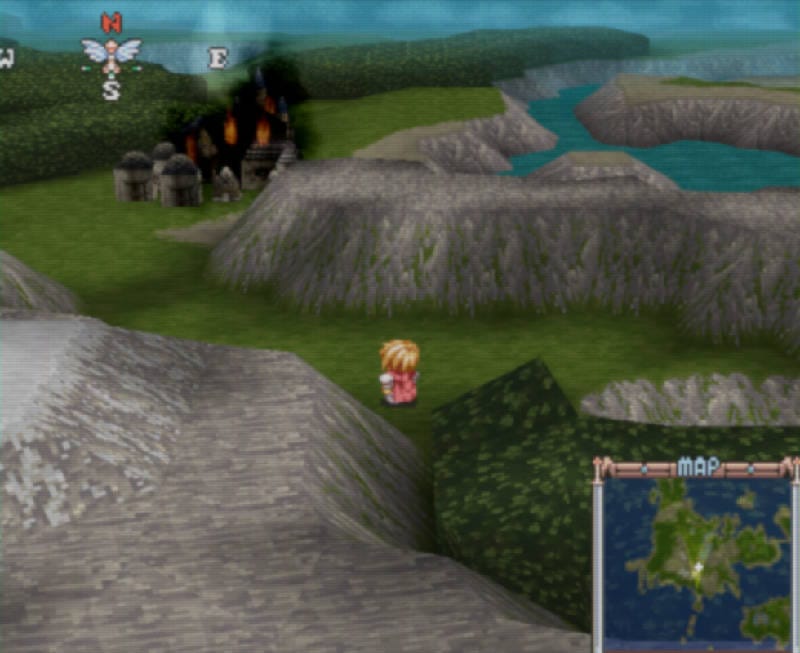
First and foremost, I need to point out that I played the game via the Phantasian Productions translation, which by consensus seems to be the best translation available at the current time (the other well known … and somewhat notorious? … option is an earlier English translation of the Super Famicom title put together by DeJap Translations). And I truly need to give proper kudos to the translation team. If I hadn’t known it was a fan translation, I would have easily believed this was simply an official English release of the game. Poignant moments of dialog hit emotional notes exactly the way that they should, humorous quips range from ‘sensible chuckle’ to downright laugh out loud, and pretty much all English phrasing is exactly as it should be. The obvious care and attention they put into the translation really shows through for the entire duration of the game. So fantastic (Phantastic?) job to Phantasian Productions!
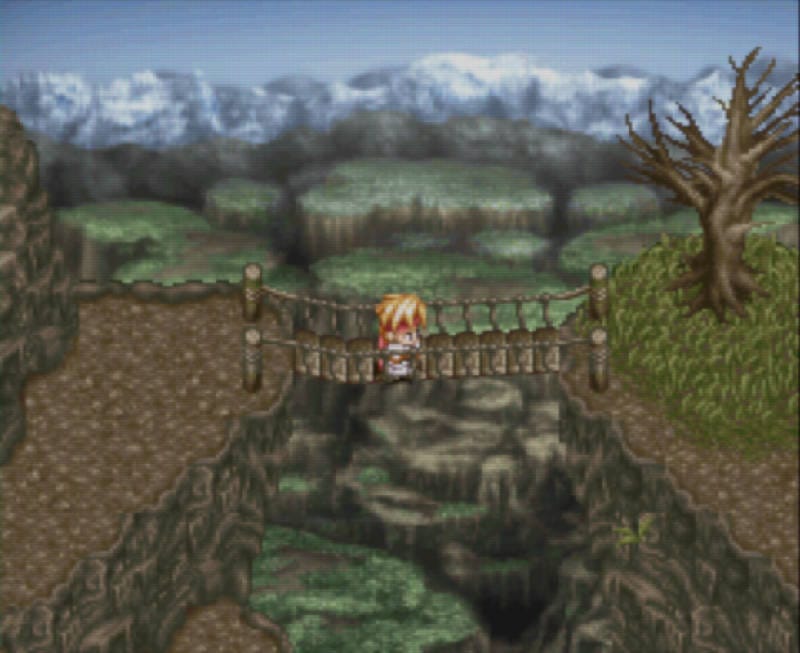
I have to be honest, the story of Tales of Phantasia is good, but at the same time … it’s not going to win any prizes for originality or innovation. We’re pretty deep in ‘by-the-numbers’ JRPG territory as far as the narrative goes. That being said, the execution of that narrative is solid and it hits its story beats in satisfying fashion. In much the same manner as the story telling, the characters in the game are also pretty well straight out of the ‘JRPG 101 Playbook’. We (thankfully) manage to skip over the trope of the ‘amnesiac hero’, but we still see many familiar faces in the roster; the outgoing yet reluctant lead, the beautiful but demurring healer, the loudmouth best friend with a heart of gold, the silent and mysterious ninja, etc. (it does need to be said that the character of Arche, responsible for carrying much of the game’s humorous moments, breaks this pattern of stereotypes. We love you Arche!). Just like the story though, while the characters are fairly familiar, the characterization is handled deftly enough that you still become attached to them all the same. So the end result is very much akin to comfort food; the story, setting and characters are very familiar and predictable, but in a way that’s also very cozy and satisfying. Chicken soup for the JRPG soul.
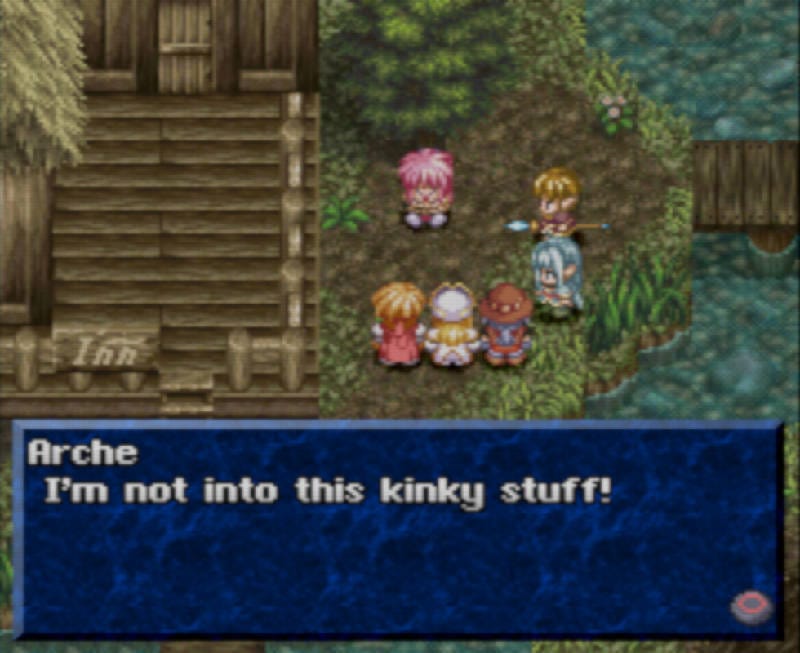
At its heart, Tales of Phantasia tells the story of Cless Albane and his companions as they battle across time against the dark sorcerer Dhaos. The game’s time-traveling narrative does add a degree of complexity to the story, taking players through different eras of their world, and allowing them to see the impact of their actions across time. Again, this kind of thing will feel very familiar to anyone who’s played Chrono Trigger, although in that comparison Chrono comes across as the more sophisticated story telling approach. And much like Chrono, the tale of … Tales of Phantasia is further enriched through some interspersed anime cutscenes, bits of voiced dialogue (particularly in combat), and additional scenes that help to flesh out the characters.
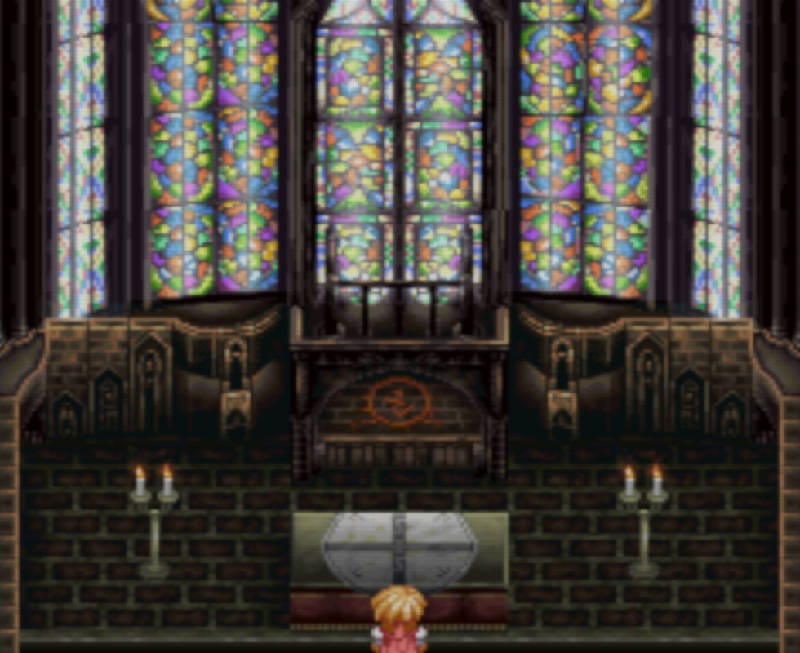
Fans of well composed music in JRPGs will find a lot to love here. The game was primarily composed and arranged by the legendary Motoi Sakuraba (as well as Shinji Tamura and Ryota Furuya) whose musical resume practically reads like a greatest hits playlist of some of the most iconic game music ever composed (particularly within the milieu of JRPGs). Here the audio capabilities of the PlayStation really go along way towards making this the best version of the game, as it enables you to fully appreciate the beautifully arranged tracks throughout.
One aspect of Tales of Phantasia that actually does break some new ground is the combat system. Once an encounter begins, your perspective shifts to a 2D side view of the action. Attacks are carried out in real time almost, but not quite, like a 2D fighting game (in point of fact one piece of equipment in the game makes it so attacks are carried out exactly as they would in a 2D fighting game, with button combos for all your various moves and attacks). I’ve never seen anything quite like it in an RPG and this aspect really helps to differentiate it from oodles of other JRPGs from this time period whose basic approach to combat amounted to, “just do whatever Square’s doing”. I have a few comments about the combat system below, but overall it was certainly a unique and fresh approach. (This is my first Tales game, but my understanding is that the series maintains and improves upon this distinctive Linear Motion Battle System going forward).
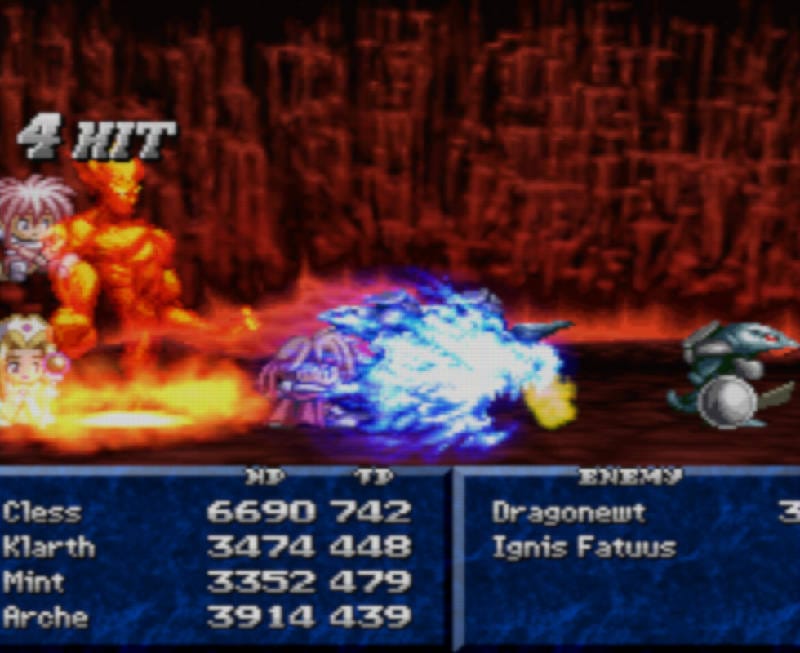
So at last the time has come to talk about a couple of details where Tales of Phantasia might have missed the mark, if only ever so slightly. Above I mentioned that I had some additional comments about the fighting system, so here they are. While the combat mechanics are innovative, the fact that they work like a simplified 2D fighting game also means you can cheese almost every fight in much the same way that you might in an unbalanced fighting game. Once you figure out that stun-locking an enemy in the corner is a nigh on unbeatable strategy, you can pretty much apply that to every fight. I took almost no damage against all three forms of the final boss in the game simply by keeping him in the corner and locked down.
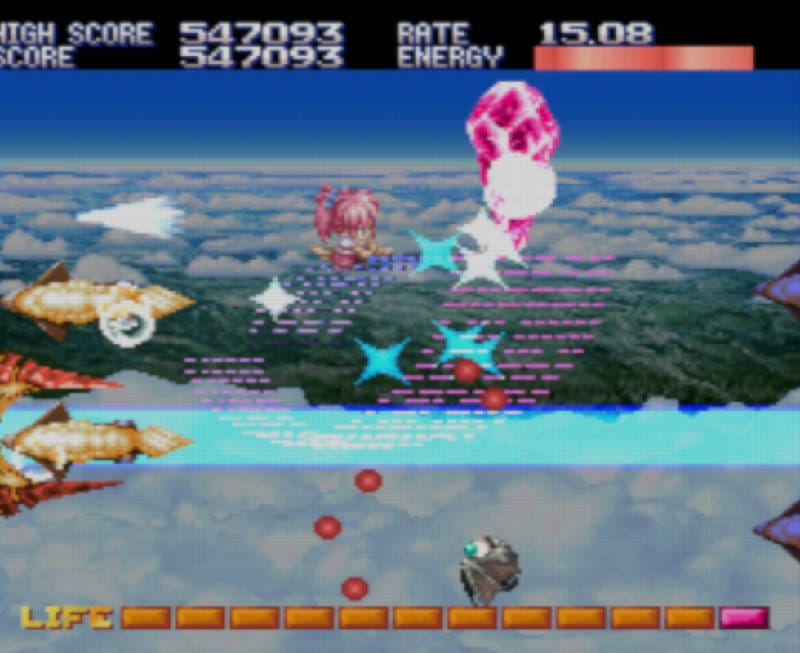
Up above I also mentioned a piece of equipment, the ‘Combo Command’, that literally turns the combat mechanics into a fighting game. At certain points you find equipment that doesn’t enhance your characters per se, but rather alters the mechanics of the game. The Combo Command is one of those. Others like the Technical Ring change the game in such a fundamental way that I would say they’re almost essential. The Technical Ring allows you to have full control over Cless during battle in such a way that you’re able to move freely around the battlefield at will. It’s a brilliant addition to the game. The trouble is that in order to use this mechanic, you have to equip the ring on Cless, and each character only has two equipment slots to begin with. So something as fundamental as having full control of your character necessitates that you sacrifice offensive/defensive/other capabilities in order to do it. The same goes for the Channeling Ring which allows for some good old fashioned couch co-op should that be your thing. And it’s maddening because not only does this compromise the mechanics of the game, it makes no sense whatsoever within the logic of the game world. Like … my character is equipped with a spear once carried by Odin, armor forged in the heart of a star, and, oh yes, the ring that allows the game to function differently. It’s slightly frustrating, but doesn’t necessarily fully hamper the enjoyment of the game.
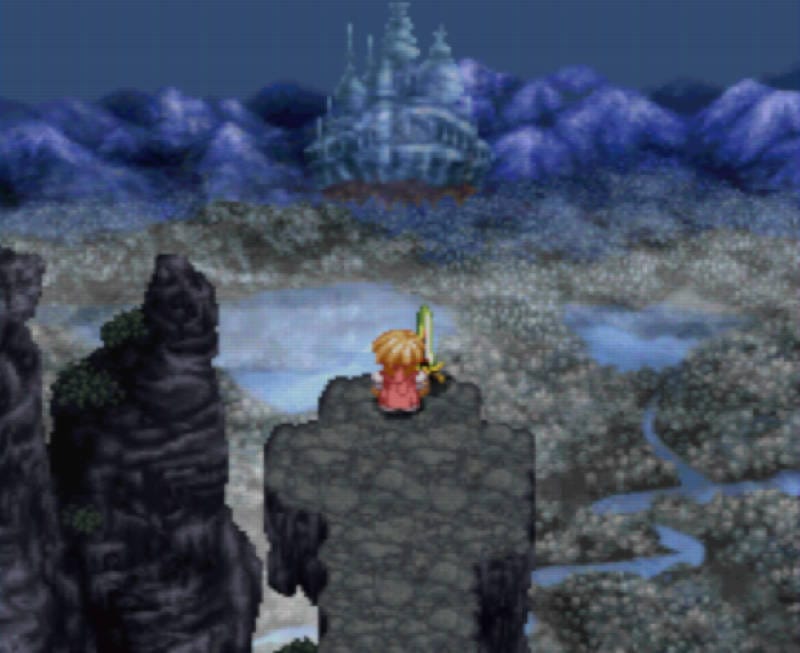
One final nitpick. You can’t discard or sell ‘???‘ items! Throughout the game, you’ll find items and equipment that can’t be initially identified, and which appear as ‘??? <item type>‘ in your inventory. Coming off the heels of Legend of Zelda: Oracle of Seasons, this is a bit like the rings you find there. In that game you can take your rings to a jeweler who then appraises them for a minimal fee, at which point you find out what you’re holding and can use them freely. In order to identify your mystery items in Tales of Phantasia you have to use a “Rune Bottle”, at which point the item becomes a known commodity. This is admittedly much more convenient than Oracle of Seasons in that you can identify your items on the spot rather than travelling all the way back to the Jeweler. Where Tales of Phantasia falters though, is that Rune Bottles are somewhat rare to find in the wild and are moderately expensive in shops. And while the equipment you find is sometimes a great upgrade, it’s often just the equivalent of what you already have, or occasionally even a huge downgrade. But most damningly, the mystery equipment still stacks up by type in your inventory. So let’s say I use a precious Rune bottle on a ‘??? Spear’ where I have ten of that particular (mysterious) type of Spear in my inventory, only to find out that it’s just your basic run-of-the-mill spear. I can sell (or more likely discard) that spear once I find out what it is. But I can’t discard the nine other ones still in ‘???‘ status, nor can I sell them or get rid of them in any other fashion. So now I’m just stuck carrying those nine ‘???‘ items until the end of the game, unless I deign to use my valuable Rune Bottles just for the sake of having an uncluttered inventory. Argh!
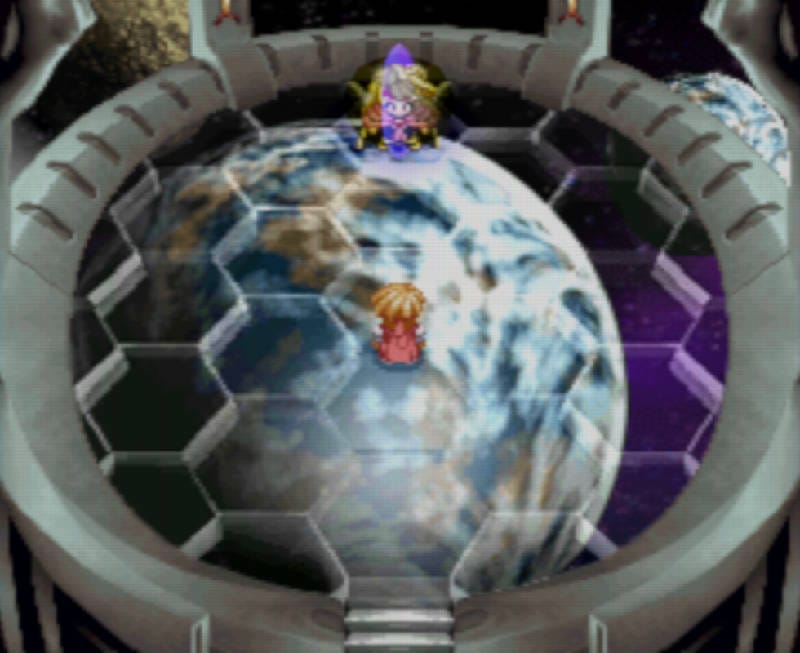
In the end though (hey we’ve finally reached the end!), these are all minor quibbles about some very nitpicky details in the game. I enjoyed Tales of Phantasia very much. The translation team did an excellent job at making the game accessible to English speaking audiences, and the game itself is pure JRPG comfort food. It’s slightly off the beaten path, so if you’re new to JRPGs, it’s probably worthwhile to start with one of the uncontested legends (vis-à-vis your Final Fantasies, Dragon Quests, Chrono Trigger, etc.). But if you’ve been around the JRPG block a time or two, and you’re looking for a game that nails the classic look, vibe and feel, Tales of Phantasia has your number. Recommended!
Final Verdict: 7 wonderful worlds of flavor out of 10
Editor’s note: I played this game on Steam Deck and when I imported all my screenshots over to PC, my image macro decided to get overzealous with the crop, resulting in the clipped images you see throughout the article. And of course I didn’t back them up prior to running the macro. So you see, this really wasn’t due to my own stupidity … it was all the macro’s fault. Yeah … that’s undoubtedly what it was.
Leave a Reply